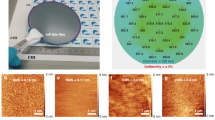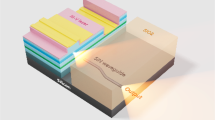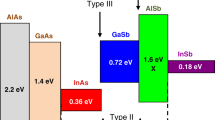Abstract
Silicon photonics would greatly benefit from efficient, visible on-chip light sources that are electrically driven at room temperature1,2. To fully utilize the benefits of large-scale, low-cost manufacturing foundries, it is highly desirable to grow direct bandgap III-V semiconductor lasers directly on Si3,4,5. Here, we report the demonstration of a blue–violet (413 nm) InGaN-based laser diode grown directly on Si that operates under continuous-wave current injection at room temperature, with a threshold current density of 4.7 kA cm–2. The heteroepitaxial growth of GaN on Si is confronted with a large mismatch in both the lattice constant and the coefficient of thermal expansion, often resulting in a high density of defects and even microcrack networks. By inserting an Al-composition step-graded AlN/AlGaN multilayer buffer between the Si and GaN, we have not only successfully eliminated crack formation, but also effectively reduced the dislocation density. The result is the realization of a blue–violet InGaN-based laser on Si.
This is a preview of subscription content, access via your institution
Access options
Subscribe to this journal
Receive 12 print issues and online access
$209.00 per year
only $17.42 per issue
Buy this article
- Purchase on Springer Link
- Instant access to full article PDF
Prices may be subject to local taxes which are calculated during checkout




Similar content being viewed by others
References
Goodman, J. W., Leonberger, F. J., Sun-Yuan, K. & Athale, R. A. Optical interconnections for VLSI systems. Proc. IEEE 72, 850–866 (1984).
Soref, R. The past, present, and future of silicon photonics. IEEE J. Sel. Top. Quantum Elect. 12, 1678–1687 (2006).
Chen, R. et al. Nanolasers grown on silicon. Nature Photon. 5, 170–175 (2011).
Wang, Z. et al. Room-temperature InP distributed feedback laser array directly grown on silicon. Nature Photon. 9, 837–842 (2015).
Chen, S. et al. Electrically pumped continuous-wave III–V quantum dot lasers on silicon. Nature Photon. 10, 307–311 (2016).
Sun, C. et al. Single-chip microprocessor that communicates directly using light. Nature 528, 534–538 (2015).
Rong, H. S. et al. A continuous-wave Raman silicon laser. Nature 433, 725–728 (2005).
Wirths, S. et al. Lasing in direct-bandgap GeSn alloy grown on Si. Nature Photon. 9, 88–92 (2015).
Liang, D. & Bowers, J. E. Recent progress in lasers on silicon. Nature Photon. 4, 511–517 (2010).
Justice, J. et al. Wafer-scale integration of group III-V lasers on silicon using transfer printing of epitaxial layers. Nature Photon. 6, 612–616 (2012).
Nakamura, S. et al. Continuous-wave operation of InGaN/GaN/AlGaN-based laser diodes grown on GaN substrates. Appl. Phys. Lett. 72, 2014–2016 (1998).
Bidnyk, S. et al. Laser action in GaN pyramids grown on (111) silicon by selective lateral overgrowth. Appl. Phys. Lett. 73, 2242–2244 (1998).
Lutsenko, E. V. et al. Growth, stimulated emission, photo- and electroluminescence of InGaN/GaN EL-test heterostructures. Phys. Status Solidi C 0, 272–275 (2002).
Shuhaimi, B. A. B. A., Kawato, H., Zhu, Y. & Egawa, T. Growth of InGaN-based laser diode structure on silicon (111) substrate. J. Phys. Conf. Ser. 152, 012007 (2009).
Kushimoto, M., Tanikawa, T., Honda, Y. & Amano, H. Optically pumped lasing properties of ( ) InGaN/GaN stripe multiquantum wells with ridge cavity structure on patterned (001) Si substrates. Appl. Phys. Express 8, 022702 (2015).
Cherns, D., Henley, S. J. & Ponce, F. A. Edge and screw dislocations as nonradiative centers in InGaN/GaN quantum well luminescence. Appl. Phys. Lett. 78, 2691–2693 (2001).
Cheng, K. et al. Flat GaN epitaxial layers grown on Si(111) by metalorganic vapor phase epitaxy using step-graded AlGaN intermediate layers. J. Electron. Mater. 35, 592–598 (2006).
Leung, B., Han, J. & Sun, Q. Strain relaxation and dislocation reduction in AlGaN step-graded buffer for crack-free GaN on Si(111). Phys. Status Solidi C 11, 437–441 (2014).
Romanov, A. E. & Speck, J. S. Stress relaxation in mismatched layers due to threading dislocation inclination. Appl. Phys. Lett. 83, 2569–2571 (2003).
Follstaedt, D. M., Lee, S. R., Allerman, A. A. & Floro, J. A. Strain relaxation in AlGaN multilayer structures by inclined dislocations. J. Appl. Phys. 105, 083507 (2009).
Heying, B. et al. Role of threading dislocation structure on the X-ray diffraction peak widths in epitaxial GaN films. Appl. Phys. Lett. 68, 643–645 (1996).
Chierchia, R. et al. Microstructure of heteroepitaxial GaN revealed by X-ray diffraction. J. Appl. Phys. 93, 8918–8925 (2003).
Sun, Q. et al. GaN-on-Si blue/white LEDs: epitaxy, chip, and package. J. Semicond. 37, 044006 (2016).
Zhu, D. et al. Efficiency measurement of GaN-based quantum well and light-emitting diode structures grown on silicon substrates. J. Appl. Phys. 109, 014502 (2011).
Tomiya, S., Hino, T., Goto, S., Takeya, M. & Ikeda, M. Dislocation related issues in the degradation of GaN-based laser diodes. IEEE J. Sel. Top. Quantum Elect. 10, 1277–1286 (2004).
Nakamura, S. et al. Room-temperature continuous-wave operation of InGaN multi-quantum-well structure laser diodes. Appl. Phys. Lett. 69, 4056–4058 (1996).
Nakamura, S. et al. High-power, long-lifetime InGaN multi-quantum-well-structure laser diodes. Jpn. J. Appl. Phys. 36, L1059–L1061 (1997).
Nam, O. H. et al. Characteristics of GaN-based laser diodes for post-DVD applications. Phys. Status Solidi A 201, 2717–2720 (2004).
Marona, L. et al. Degradation mechanisms in InGaN laser diodes grown on bulk GaN crystals. Appl. Phys. Lett. 88, 201111 (2006).
Nakamura, S. The roles of structural imperfections in InGaN-Based blue light-emitting diodes and laser diodes. Science 281, 956–961 (1998).
Acknowledgements
The authors are grateful for the financial support from the National Key Research and Development Program (Grant No. 2016YFB0400104), the National Natural Science Foundation of China (Grant Nos. 61534007, 61404156, 61522407 and U1501241), the Strategic Priority Research Program of the Chinese Academy of Science (Grant No. XDA09020401), the Natural Science Foundation of Jiangsu Province (Grant No. BK20160401), the China Postdoctoral Science Foundation (Grant No. 2016M591944) and the Chinese Academy of Sciences Visiting Professorship for Senior International Scientists (Grant No. 2013T2J0048). This work was also supported by the open fund of the State Key Laboratory of Luminescence and Applications (Grant No. SKLA-2016-01) and the seed fund from SINANO, CAS (Grant No. Y5AAQ51001). We are thankful for the technical support from Nano Fabrication Facility, Platform for Characterization & Test, Nano-X of SINANO, CAS, M. Niu's assistance in TEM imaging and J. Han's help in proofreading.
Author information
Authors and Affiliations
Contributions
Q.S., H.Y. and S.L. proposed and coordinated the overall project. Q.S., M.I., J.L. and S.Z. proposed the epitaxial structure. K.Z., J.L. and M.F. performed the simulation. Q.S. and Z.L. grew the GaN-on-Si template, K.Z., Y.S., Q.S., J.L., M.F. and M.I. carried out the LD epitaxial growth. Y.S., M.F., Y.Z., L.Z. and S.Z. fabricated the GaN-on-Si LD devices. Y.S., K.Z., Y.Z., Z.L. and D.L. measured the GaN-on-Si LD devices. Y.S., Q.S. and H.Y. composed and revised the manuscript. S.L. and M.I. proofread the manuscript.
Corresponding author
Ethics declarations
Competing interests
The authors declare no competing financial interests.
Supplementary information
Supplementary information
Supplementary information (PDF 710 kb)
Rights and permissions
About this article
Cite this article
Sun, Y., Zhou, K., Sun, Q. et al. Room-temperature continuous-wave electrically injected InGaN-based laser directly grown on Si. Nature Photon 10, 595–599 (2016). https://doi.org/10.1038/nphoton.2016.158
Received:
Accepted:
Published:
Issue Date:
DOI: https://doi.org/10.1038/nphoton.2016.158
This article is cited by
-
Unlocking the monolithic integration scenario: optical coupling between GaSb diode lasers epitaxially grown on patterned Si substrates and passive SiN waveguides
Light: Science & Applications (2023)
-
Study of short-wavelength red semiconductor laser using high Ga composition GaInP quantum well based on Ge/SiGe substrate
Applied Physics B (2023)
-
Electrically driven single microwire-based single-mode microlaser
Light: Science & Applications (2022)
-
Role of dislocations in nitride laser diodes with different indium content
Scientific Reports (2021)
-
Structural, electronic, and optical properties of AlNxSb1−x alloys through TB–mBJ–PBEsol: DFT study
Journal of Computational Electronics (2019)



